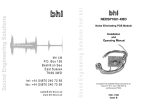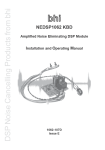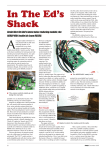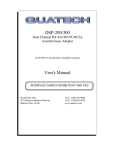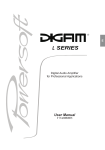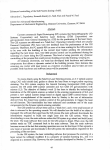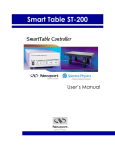Download BHI Noise Away Service manual
Transcript
bhi ltd P.O. Box 136 Bexhill on Sea East Sussex TN39 3WD tel: +44 (0)870 240 72 58 fax: +44 (0)870 240 72 59 [email protected] www.bhi-ltd.co.uk Page 20 Sound Engineering Solutions from bhi Sound Engineering Solutions bhi bhi NEDSP1061-KBD Noise Eliminating PCB Module Generic Installation and Operating Manual 1061-110D Issue A Page 1 Important Information Notes: Copyright This publication, including all photographs and illustrations is protected under international copyright laws, with all rights reserved. Neither this manual, nor any of the material within, may be copied or reproduced without the written consent of bhi Ltd. Disclaimer The information in this document is subject to change without notice. bhi Ltd. makes no representations or warranties with respect to the contents hereof and specifically disclaims any implied warranties of merchantability or fitness for any particular purpose. Furthermore, bhi Ltd. reserves the right to revise this publication and to make changes from time to time in the content hereof without obligation of bhi Ltd. to notify any person of such revision or changes. The fitting of the bhi NEDSP1061-KBD module may involve the removal of small surface mount components and the drilling out of the transceivers’ case. This should only be carried out by a qualified engineer. bhi accepts no responsibility for the fitting or installation of the NEDSP1061-KBD module and are not liable for any damage to equipment caused by its fitment. Fitting this module may invalidate your warranty. All attempts have been made to ensure that this information is up to date. It is possible that these instructions contain errors, or the equipment is slightly different to the one used to compile this information. In all cases it is up to the installer to ensure that the module is fitted correctly. By installing this module you are doing so at your own risk. Page 2 Page 19 Packing List: 7. Machining details Hole machining details. Please check the contents of the box. n n n n n DSP PCB Mounting hole detail 27.3mm Operating manual NEDSP1061-KBD assembly Z bracket Self adhesive mounting pads bhi NEDSP label 21.0mm To install this module you will need the following additional items: n service manual/circuit diagram of the equipment in which the module is to be installed. n all the appropriate tools to disassembling the equipment n suitable soldering iron and bits for working with surface mount devices. 4 holes 3.0mm diameter 4.0mm diameter (switch) 3.5mm diameter (LED) Before attempting to fit this module study this manual thoroughly along with the service manual for your equipment. 5.1mm Keyboard holes Page 18 Page 3 Contents 1. Introduction 1.1 NEDSP1061-KBD features 1.2 Limitations 1.3 Audio DSP noise cancellation 5 5 6 6.3.2 Demonstration 2: Follow the procedure as above. Wait for the second 2 tone beep, then release the key. In this mode the filter level is set to level 3. 2. Module description 2.1 Module layout 2.2 Connections 2.3 Electrical characteristics 2.4 Controls 2.4.1 Input level 2.4.2 Output level 2.4.3 Beep volume level 2.4.4 Overload LED 2.5 Module mounting 7 7 8 8 8 8 8 8 9 Installation 3.1 Introduction 3.2 Circuit location 3.3 Fitting 3.3.1 Audio connections 3.3.2 Power connections 10 10 10 11 11 12 6.4 Notes about the noise reduction. When using the module on level 4 some distortion may be heard. This is quite normal when listening to high levels of noise at level 4. 4. Setup 13 6.5 Noise reduction levels. 5. Troubleshooting 14 L evel Tone Reduction White Noise Reduction 6. Operation 6.1 Introduction 6.2 Operation 6.3 Demonstration mode 6.4 Notes about noise reduction 6.5 Noise redcution level Machining drawings 15 15 15 16 16 17 18 1 5dB 11dB 2 8dB 13dB 3 21dB 20dB 4 65dB 35dB 3. 7. Page 4 The noise cancellation is switched on for 3 seconds, then off for 3 seconds. This loops until the user aborts this mode. This is a good demonstration for listening noisy SSB conversations showing the before and after. 6.3.3 Exiting the demonstration mode. Hold down the button until the 2 tone beep is heard. Release the button. After a short delay the LED will flash indicating the stored level, as during the normal switch on. Page 17 Noise cancellation on/off. Press and release the button and the led will extinguish, and the noise cancellation will be activated. A short beep will acknowledge the key press. Changing the filter level. Hold down the button. The led will flash the filter level, and if the button is held it will step through all the levels. When the desired level has been reached release the button. This new value will be stored in the modules’ memory and will be the default setting the next time the unit is powered up. 6.3. Demonstration mode. The NEDSP1061-KBD module features 2 preset demonstration modes. These demonstrate the noise cancellation abilities of the NEDSP1061 module. 6.3.1 Demonstration 1: Hold down the button and switch on the equipment. After a short time the unit will emit a 2 tone beep. Release the button. The unit is now in demonstration mode 1. The module will switch the noise cancellation on for 1.5 seconds, then off for 1.5 seconds. It will then move onto the next level and repeat this continuously through all 4 levels. This mode a particularly effective when the equipment is just receiving static, as it demonstrates the attenuation of white noise at all the levels. Alternatively tune the equipment into a good quality FM speech broadcast. This demonstration shows how little the DSP alters the speech, at any of the levels. Page 16 1. Introduction The NEDSP1061-KBD is a modular solution to noise reduction. It incorporates DSP technology to provide up to 35dB of noise cancellation. The module is controlled by a single pushbutton with LED indication for ease of use. 1.1 NEDSP1061-KBD module features: n n n n n n n n n n n Fully adaptive to changing noise environments Input and output level controls Input overload indication Virtually no distortion to speech signal Up to 35dB of noise cancellation 4 levels of noise reduction 5 – 15V supply range 4.6dB on board gain Single key operation of all functions LED indication of DSP level and status Small size 26mm x 37mm 1.2 Limitations. This module is designed to pass speech. Other signals such as data and music will to some degree pass through, but the integrity of these signals cannot be guaranteed. This module is designed to be placed in a low level audio path only. The module will not drive a loudspeaker or other high power load (see bhi amplified DSP module). The unit is single channel (mono). Page 5 This module is designed for communication type applications. The upper frequency limit is 4.5KHz and therefore not suitable for hi fidelity applications. 1.3 Audio DSP Noise cancellation. The bhi DSP processes the incoming audio signal and then differentiates the speech from the noise. The unwanted noise and interference is then attenuated to leave only the speech. The following diagrams are taken from actual audio signals and illustrate how the audio signal is being processed. Speech Noise Original signal. Speech with a lot of background noise Processed speech. Speech with reduced noise Reduced noise 6. Operation 6.1 Introduction. All functions of the NEDSP1061-KBD are controlled by a single button. • • Single press turns the noise cancellation on/off. Holding down the button changes the DSP filter level. The mode of operation is indicated both visually and audibly. The LED is illuminated red when the noise cancellation is off. When the noise cancellation level is changed the LED will flash green to indicate which level has been selected. Simultaneously the DSP will beep to give audible indication of DSP level. This allows the operator to change the DSP level without having to look at the LED to see which level has been selected. A short beep is emitted to acknowledge a button press. The module will store the current DSP level, and will return to this level when the equipment is switched on. 6.2 Operation. Switch on the equipment. The LED will illuminate red to indicate the noise cancellation is off. The unit will flash/beep to indicate the DSP filter level last used. Figure 1. Noise cancellation. Page 6 Page 15 5. Troubleshooting 2. Module description 2.1 Module Layout. Start The following diagram shows the layout of the NEDSP1061-KBD module. Audio Distortion Overload LED Illuminates (P1) Yes Output level Overload LED Input level (P2) + + Keyboard PCB + Reduce Input Level using P2. No Reduce Output Level using P1. Pushbutton DSP PCB Mounting holes (4 off) M3 Ring Tag (0V) Top Red wire (5-15VDC) Beep volume control Bi Colour LED Screened Audio Lead (Audio In/Out) (P3) Yes Distortion Figure 2. Module layout. 2.2 Module Connections. No The NEDSP1061-KBD module has five connections. End Figure 6. Troubleshooting flowchart. Page 14 Red wire: M3 Tag: Screened Lead: 5 - 15VDC 0V Red Blue Black Audio In Audio Out Audio Screen Page 7 2.3 Electrical characteristics. 4. Setup Electrical Characteristics Parameter Description V in Supply voltage Iin Supply current In Audio input signal Out Audio output signal (1.7 Xs input max) Min Typ Max Units 5 9 15 V 45 50 mA 50 300 Vrms 630 Vrms Table 1. NEDSP1061-KBD Electrical characeristics The levels come factory set to the maximum position. This should be adequate for most applications. However the module can be adjusted as follows. Tune the equipment to a strong signal. Switch off the noise reduction (LED will illuminate RED). Adjust the input P2 until the overload led illuminates. Back off the pot slightly. 2.4 Controls. Adjust P3 to give the correct listening volume, without distortion. Controls are provided to allow the NEDSP1061-KBD to be integrated in to the target system. 3 level controls are provided. Adjust P1 to give the desired beep volume level, or off if required. 2.4.1 Input Level: To set the audio level to the optimum level for the DSP. 2.4.2 Output Level: To match the output level of the DSP module to that of the following stage. 2.4.3 Beep volume level: Allows the user to adjust the beep volume control to suit. The beep volume can be reduced to zero if required. The modules are factory set to the maximum level. Turning the potentiometers anti clock wise will increase the levels. Page 8 Page 13 connection (this screens the cable and acts as a mechanical fixing for the cable, protecting the capacitor pads). 3.3.2 Power connections. 5 - 15VDC (9V typically) is required to operate the module. The lower the voltage, the less heat the module will have to dissipate. Locate a convenient point to connect the power. Ensure that this point is connected after the power switch, otherwise the DSP module will be drawing power all the time, and may flatten the batteries (where fitted). Connect the red wire to this point. The 0V connection is formed using the M3 ring tag. Locate a suitable 0V point (such as a PCB retaining screw that is fixed into the chassis). When routing the wires, ensure they are away from strong sources of RF or high voltage. Note: The potentiometers do not have end stops. It is possible to set the potentiometer in a dead band between the ends, resulting in the audio being lost. 2.4.4 Overload LED. The overload LED circuit monitors the amplitude of the audio level entering the DSP module. The LED will illuminate when the amplitude exceeds the maximum permitted level. If the amplitude is increased further the DSP will clamp the audio signal to prevent damage to the DSP input. This will cause the audio signal to become distorted. The optimum level is achieved when the loudest peaks of the input audio, just cause the LED to glow. 2.5 Module mounting. The DSP module has four mounting holes that can be used to retain the unit inside the equipment. Alternatively a self adhesive pad is supplied to allow the module to be mounted in a convenient position - without the need for drilling. Two holes need to be drilled in the casing of the equipment for the keyboard. Hole sizes and positions can be found in section 7. The keyboard can retained using the supplied ‘Z’ bracket or alternatively retained using a suitable adhesive, or the mounting pads supplied. In some equipment it may be possible to clamp the bracket under the loudspeaker bracket. Cover the keyboard holes with the supplied self adhesive label. Page 12 Page 9 Audio source Pre-amp Volume Control Loudspeaker Audio Out (Blue) 3.2 Circuit location. The NEDSP1061-KBD module is inserted into the path of noisy audio. Using the input and output level controls allows the unit to appear transparent to the audio signal. Coupling Capacitor Audio In (Red) 3.1 Introduction. Before commencing installation study the equipment’s service manual/circuit diagram thoroughly to familiarise yourself with the circuit diagram and disassembly procedure. For optimum performance provide the module with a constant amplitude signal, for example before the volume control. Remove this Black (Screen) 3. Installation Power Amp NEDSP1061 Audio out Pre amp NEDSP1061 Place the NEDSP1061 In place of the Coupling capacitor Power amp Figure 5. NEDSP1061-KBD recommended position. Note: On some modern receivers/transceivers the volume control is digital and doesn’t operate in the audio path.Contact the manufacturer for advise for the most suitable postion for theDSP module.. Figure 3. Basic connection diagram Place NEDSP1061-KBD module in place of the coupling capacitor Audio out Audio source Pre amp Power amp Remove this Capacitor NEDSP1061 Figure 4. NEDSP1061-KBD Audio path Page 10 3.3 Fitting. After locating a suitable location for the module in the circuit, refer to the service manual for diassembly information. 3.3.1 Audio connections. Carefully remove the chosen coupling capacitor, taking care to not damage the PCB pads. Solder the blue wire from the screened lead to the power amp side of the capacitor and the red to the other. The black wire should be connected to a convenient 0V Page 11










